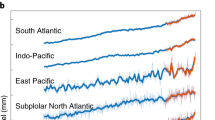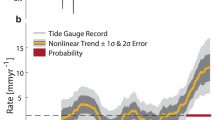Abstract
Climate warming does not force sea-level rise (SLR) at the same rate everywhere. Rather, there are spatial variations of SLR superimposed on a global average rise. These variations are forced by dynamic processes1,2,3,4, arising from circulation and variations in temperature and/or salinity, and by static equilibrium processes5, arising from mass redistributions changing gravity and the Earth’s rotation and shape. These sea-level variations form unique spatial patterns, yet there are very few observations verifying predicted patterns or fingerprints6. Here, we present evidence of recently accelerated SLR in a unique 1,000-km-long hotspot on the highly populated North American Atlantic coast north of Cape Hatteras and show that it is consistent with a modelled fingerprint of dynamic SLR. Between 1950–1979 and 1980–2009, SLR rate increases in this northeast hotspot were ∼ 3–4 times higher than the global average. Modelled dynamic plus steric SLR by 2100 at New York City ranges with Intergovernmental Panel on Climate Change scenario from 36 to 51 cm (ref. 3); lower emission scenarios project 24–36 cm (ref. 7). Extrapolations from data herein range from 20 to 29 cm. SLR superimposed on storm surge, wave run-up and set-up will increase the vulnerability of coastal cities to flooding, and beaches and wetlands to deterioration.
This is a preview of subscription content, access via your institution
Access options
Subscribe to this journal
Receive 12 print issues and online access
$209.00 per year
only $17.42 per issue
Buy this article
- Purchase on Springer Link
- Instant access to full article PDF
Prices may be subject to local taxes which are calculated during checkout




Similar content being viewed by others
Change history
26 April 2013
The authors have updated the Supplementary Information to include the numerical results of the rate difference calculations for total window lengths of 60 years (Table S4), 50 years (Table S5) and 40 years (Table S6). These data are in spreadsheet form and provide the numerical values represented in Figs 1 and 2 in the main text and Fig. S3. These changes have been made in this file 26 April 2013.
References
Levermann, A., Griesel, A., Hofmann, M., Montoya, M. & Rahmstorf, S. Dynamic sea level changes following changes in the thermohaline circulation. Clim. Dynam. 24, 347–354 (2005).
Landerer, F. W., Jungclaus, J. & Marotzke, J. Regional dynamic and steric sea level change in response to the IPCC-A1B scenario. J. Phys. Oceanogr. 37, 296–312 (2007).
Yin, J., Schlesinger, M. E. & Stouffer, R. J. Model projections of rapid sea-level rise on the northeast coast of the United States. Nature Geosci. 2, 262–266 (2009).
Hu, A., Meehl, G., Han, W. & Yin, J. Effect of the potential melting of the Greenland Ice Sheet on the meridional overturning circulation and global climate in the future. Deep-Sea Res. II 58, 1914–1926 (2011).
Mitrovica, J. X., Tamisiea, M. E., Davis, J. L. & Milne, G. A. Recent mass balance of polar ice sheets inferred from patterns of global sea-level change. Nature 409, 1026–1029 (2001).
Douglas, B. C. Concerning evidence for fingerprints of glacial melting. J. Coast. Res. 24, 218–227 (2008).
Schleussner, C. F., Frieler, K., Meinshausen, M., Yin, J. & Levermann, A. Emulating Atlantic overturning strength for low emission scenarios: Consequences for sea-level rise along the North American east coast. Earth Syst. Dynam. 2, 1–10 (2011).
Maximenko, N. et al. Mean dynamic topography of the ocean derived from satellite and drifting buoy data using three different techniques. J. Atmos. Ocean. Tech. 26, 1910–1919 (2009).
Rio, M-H. & Hernandez, F. A mean dynamic topography computed over the world ocean from altimetry, in situ measurements, and a geoid model. J. Geophys. Res. 109, C12032 (2004).
Krauss, W. The North Atlantic current. J. Geophys. Res. 91, 5061–5074 (1986).
Curry, R. G. & McCartney, M. S. Ocean gyre circulation changes associated with the North Atlantic Oscillation. J. Phys. Oceanogr. 31, 3374–3400.
Hakkinen, S. & Rhines, P. B. Decline of subpolar North Atlantic circulation during the 1990s. Science 304, 555–559 (2004).
Douglas, B. C. in Sea Level Rise: History and Consequences (eds Douglas, B. C., Kearney, M. S. & Leatherman, S.P.) 37–64 (Inter. Geophys. Ser., Vol. 75, Academic, 2001).
Church, J. A. & White, N. J. Sea-level rise from the late 19th to the early 21st Century. Surv. Geophys. 32, 585–602 (2011).
Merrifield, M. A., Merrifield, S. T. & Mitchum, G. T. An anomalous recent acceleration of global sea level rise. J. Clim. 22, 5772–5781 (2009).
Houston, J. R. & Dean, R. G. Sea-level acceleration based on US tide gauges and extensions of previous global-gauge analyses. J. Coastal Res. 27, 409–417 (2011).
Doran, K. J. Addressing the Problem of Land Motion at Tide Gauges, M. S. thesis 1616, College of Marine Science, Univ. South Florida (2010).
Rignot, E., Velicogna, I., van den Broeke, M. R., Monaghan, A. & Lenaerts, J. Acceleration of the contribution of the Greenland and Antarctic ice sheets to sea level rise. Geophys. Res. Lett. 38, L05503 (2011).
Frauenfeld, O. W., Knappenberger, P. C. & Michaels, P. J. A reconstruction of annual Greenland ice melt extent, 1784–2009. J. Geophys. Res. 116, D08104 (2011).
Abdalati, W. & Steffen, K. Greenland ice sheet melt extent: 1979–1999. J. Geophys. Res. 106, 33983–33989 (2001).
Mote, T. L. Greenland surface melt trends 1973–2007: Evidence of a large increase in 2007. Geophys. Res. Lett. 34, L22507 (2007).
Rignot, E., Koppes, M. & Velicogna, I. Rapid submarine melting of the calving faces of West Greenland glaciers. Nature Geosci. 3, 187–191 (2010).
Yin, J. et al. Different magnitudes of projected subsurface ocean warming around Greenland and Antarctica. Nature Geosci. 4, 524–528 (2011).
Yin, J., Griffies, S. & Stouffer, R. Spatial variability of sea level rise in twenty-first century projections. J. Clim. 23, 4585–4607 (2010).
Box, J. E., Yang, L., Bromwich, D. H. & Bai, L-S. Greenland ice sheet surface air temperature variability: 1840–2007. J. Clim. 22, 4029–4049 (2009).
Booth, B. B. B. et al. Aerosols implicated as a prime driver of twentieth-century North Atlantic climate variability. Nature 484, 288–232 (2012).
Frankcombe, L. & Dijkstra, H. Geophys. Res. Lett. 36, L15604 (2009).
Fletcher II, C. H., Van Pelt, J. E., Brush, G. S. & Sherman, J. Tidal wetland record of Holocene sea-level movements and climate history. Palaeogeogr. Palaeoclimatol. Palaeoecol. 102, 177–213 (1993).
Boon, J. D., Brubaker, J. M. & Forrest, D. R. Chesapeake Bay Land Subsidence and Sea Level Change: An Evaluation of Past and Present Trends and Future Outlook Special Report No. 425 in Applied Marine Science and Ocean Engineering (Virginia Institute of Marine Science, 2010).
Maul, G. A. & Martin, D. M. Sea level rise at Key West, Florida, 1846–1992: America’s longest instrument record? Geophys. Res. Lett. 20, 1955–1958 (1993).
Acknowledgements
The USGS Coastal and Marine Geology Program provided the financial support for this work. We thank the following for providing comments on our manuscript before submission: R. A. Holman, J. Boon, C. Fletcher, N. Plant, E. R. Thieler, L. Robbins and J. List. We also thank G. Mitchum, P. Thompson and J. Haines for useful discussions about dynamic SLR and results presented in this paper. K. Morgan assisted with preparation of the final figures.
Author information
Authors and Affiliations
Contributions
A.H.S. conceived the study, developed hypotheses and tests, supervised the work and wrote the main text. K.S.D. conducted the calculations, and posed and carried out sensitivity and statistical tests. P.A.H. designed statistical tests, developed/tested methods and wrote the Methods and Supplementary Information.
Corresponding author
Ethics declarations
Competing interests
The authors declare no competing financial interests.
Supplementary information
Supplementary Information
Supplementary Table S4 (XLS 50 kb)
Supplementary Information
Supplementary Table S5 (XLS 51 kb)
Supplementary Information
Supplementary Table S6 (XLS 53 kb)
Rights and permissions
About this article
Cite this article
Sallenger, A., Doran, K. & Howd, P. Hotspot of accelerated sea-level rise on the Atlantic coast of North America. Nature Clim Change 2, 884–888 (2012). https://doi.org/10.1038/nclimate1597
Received:
Accepted:
Published:
Issue Date:
DOI: https://doi.org/10.1038/nclimate1597
This article is cited by
-
Compensatory Mechanisms Absorb Regional Carbon Losses Within a Rapidly Shifting Coastal Mosaic
Ecosystems (2024)
-
Shrub Age and Water Dynamics Influence Primary Production, Carbon, and Nitrogen Stocks in a Coastal Environment
Wetlands (2024)
-
SDG 12 needs an oceanic interface: sand mining, saltwater intrusion (SWI) and coastal sustainability
Sustainable Earth Reviews (2023)
-
Acceleration of U.S. Southeast and Gulf coast sea-level rise amplified by internal climate variability
Nature Communications (2023)
-
Hidden vulnerability of US Atlantic coast to sea-level rise due to vertical land motion
Nature Communications (2023)



